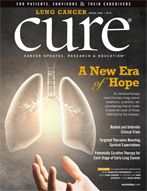Publication
Article
CURE
Striving for Precision
Author(s):
FOR MOST OF OUR medical history, people diagnosed with cancer were treated based on where their disease was found — breast cancer with drugs for breast cancer, melanoma with drugs designed for melanoma. But as our understanding of the human genome leads to a host of precision treatments, a cancer’s primary site of occurrence is becoming a secondary concern.
Certain cases of melanoma, lung cancer, HER2-positive breast cancer, colorectal cancer, leukemia and many other cancer types can be treated with FDA-approved drugs that target specific genetic mutations or rearrangements. In addition, there are approved immunotherapies for the treatment of cancers including melanoma, non-small cell lung cancer and renal cell carcinoma.
While these drugs don’t work for everyone, they can be very successful for some patients with advanced disease, for whom other options are few or nonexistent. Soon, these types of treatments may be used in earlier-stage cancers, too. It’s the kind of tailor-made, individualized medicine oncology experts have been talking about for years, and it’s becoming a reality before our eyes.
So what will make these strategies accessible to larger swaths of the patient community? That’s what top researchers around the United States are working to find out through a new brand of clinical trial. Known as either basket or umbrella trials, these studies match patients to medicines based on the mutations that drive their cancers, rather than on where the cancers first appeared. It’s an endeavor that will include many patients with lung cancer, and a topic we look at closely in this special issue of CURE.
In the LUNG-Map trial, for instance, patients with advanced squamous nonsmall cell lung cancer will undergo genomic screening and then, if eligible, be assigned to one of four treatment arms. The NCI-MATCH and TAPUR trials, meanwhile, are enrolling people with numerous cancer types and will choose from a variety of targeted drugs to treat those with appropriate mutations.
The number of basket and umbrella trials is still small, because they involve a high level of collaboration between pharmaceutical companies, academia and, often, the government, which can make them difficult to organize. But those launched are large and well-designed, meaning that, if they demonstrate successful results, they could not only result in better treatments for more patients, but also prove the value of this type of trial. This could lead to more such studies and, eventually, a much broader application of precision medicine in cancer care.
Elsewhere in this issue, we dissect the worlds of lung cancer immunotherapy and targeted treatment, looking at standards of care and what’s in the pipeline. And we consider the latest in local and systemic therapies for earlier-stage lung cancers.
Finally, we share the results of a study confirming that lung cancer can carry a stigma due to its association with smoking — confirming a phenomenon our readers affected by the disease may have already experienced.
We hope you find this issue to be a well-rounded look at what you need to know about lung cancer, and that the scientific progress reflected in these pages provides inspiration about the future of treatment for this disease.
As always, thank you for reading.
MIKE HENNESSY, SRChairman and CEO






